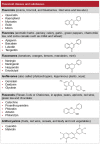Flavonoids in Kidney Health and Disease
- PMID: 29740333
- PMCID: PMC5928447
- DOI: 10.3389/fphys.2018.00394
Flavonoids in Kidney Health and Disease
Abstract
This review summarizes the latest advances in knowledge on the effects of flavonoids on renal function in health and disease. Flavonoids have antihypertensive, antidiabetic, and antiinflammatory effects, among other therapeutic activities. Many of them also exert renoprotective actions that may be of interest in diseases such as glomerulonephritis, diabetic nephropathy, and chemically-induced kidney insufficiency. They affect several renal factors that promote diuresis and natriuresis, which may contribute to their well-known antihypertensive effect. Flavonoids prevent or attenuate the renal injury associated with arterial hypertension, both by decreasing blood pressure and by acting directly on the renal parenchyma. These outcomes derive from their interference with multiple signaling pathways known to produce renal injury and are independent of their blood pressure-lowering effects. Oral administration of flavonoids prevents or ameliorates adverse effects on the kidney of elevated fructose consumption, high fat diet, and types I and 2 diabetes. These compounds attenuate the hyperglycemia-disrupted renal endothelial barrier function, urinary microalbumin excretion, and glomerular hyperfiltration that results from a reduction of podocyte injury, a determinant factor for albuminuria in diabetic nephropathy. Several flavonoids have shown renal protective effects against many nephrotoxic agents that frequently cause acute kidney injury (AKI) or chronic kidney disease (CKD), such as LPS, gentamycin, alcohol, nicotine, lead or cadmium. Flavonoids also improve cisplatin- or methotrexate-induced renal damage, demonstrating important actions in chemotherapy, anticancer and renoprotective effects. A beneficial prophylactic effect of flavonoids has been also observed against AKI induced by surgical procedures such as ischemia/reperfusion (I/R) or cardiopulmonary bypass. In several murine models of CKD, impaired kidney function was significantly improved by the administration of flavonoids from different sources, alone or in combination with stem cells. In humans, cocoa flavanols were found to have vasculoprotective effects in patients on hemodialysis. Moreover, flavonoids develop antitumor activity against renal carcinoma cells with no toxic effects on normal cells, suggesting a potential therapeutic role in patients with renal carcinoma.
Keywords: acute kidney injury; arterial hypertension; chronic kidney disease; diabetes mellitus; flavonoids; kidney function; nephroprotection.
Figures





References
-
- Bagheri F., Gol A., Dabiri S., Javadi A. (2011). Preventive effect of garlic juice on renal reperfusion injury. Iran J. Kidney Dis. 5, 194–200. - PubMed
Publication types
LinkOut - more resources
Full Text Sources
Other Literature Sources

